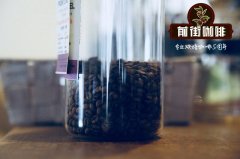Coffee origin: what are the producing areas of Guatemala in Guatemala?
Coffee origin: what are the producing areas of Guatemala in Guatemala?

The extra hard coffee beans here are full-grained, delicious and balanced, and the coffee made with them is pure and full-bodied.
Guatemala coffee once enjoyed a reputation as the best quality coffee in the world, but its quality also declined for a time. What is gratifying, however, is that its reputation is gradually being restored.
In 1750, Father Jesuit introduced coffee trees to Guatemala, where the coffee industry was developed by German colonization at the end of the 19th century. Today, most of the coffee industry's production takes place in the south of the country. Here, the slopes of Sierra Madre volcano provide ideal conditions for growing high-quality coffee beans, and coffee growing at high altitudes is full of vitality. Compared with other kinds of coffee, tasters prefer this mixed flavor coffee with spicy flavor. The extra-hard coffee beans here are a rare good coffee with full grains, delicious taste and balanced acidity. In addition, Guatemala has attracted a lot of attention because of its giant coffee beans.
The coffee industry, which once boomed the country, still dominates the national economy. Unfortunately, the domestic political situation is not good for coffee growers. High output is usually a sign of a country's overall economic prosperity. However, coffee production in Guatemala has declined relatively, at 700kg per hectare, while that in El Salvador is 900kg per hectare and that in Costa Rica is even more astonishing, at 1700 kg per hectare. The export of Guatemalan coffee is controlled by private companies, but the National Coffee Council (Asociacion Nacional de Cafe) controls other sectors of the coffee industry. At present, some of the best quality coffee from Guatemala is exported to Japan, where each cup of coffee sells for $3 to $4.
Most small-scale producers are descended from the Mayans (Mayan), who like to call cups local people. Currently, they are also benefiting from a U.S.-funded project, known locally as The Project, which plans to invest $2.5 million to encourage the opening of small, high-quality coffee plantations. The main areas rich in high-quality coffee in Guatemala are Lake Attilan (Lake Atitlan) and Huehuentenango. The purpose of the project is to help restore the vicious circle of high yield and low quality that has plagued the world coffee industry. For example, Bourbon trees grow taller and produce fewer beans than the new dwarf trees, and although they all belong to Arabica coffee varieties, bourbon trees produce better beans and are more popular with gourmets. The project also hopes to encourage local producers to process their own coffee beans, as most coffee fruits are now sold to middlemen, and if coffee processing can be done in local factories, its value and even quality may be improved.
Antigua (Antigua) is also a famous producer of coffee. Antigua coffee is produced in Hacienda Carmona, where the best quality coffee is EL Pulcal, which is not only of good quality, but also has a stronger flavor, richer taste and stronger tobacco flavor than other Guatemalan coffees. Every 30 years or so, the area near Antigua is hit by a volcanic eruption, which provides more nitrogen to the already fertile land, and plenty of rainfall and sunlight make the place more suitable for growing coffee.
Other coffee producers include San Marco, Oriente & Coban, Palcya, Mataquescuintia and La Uman in Zacapa. The establishment of the Special Coffee Association means that the Government of Guatemala has begun to pay attention to high-quality coffee, and the efforts made for it will soon bear fruit.
Guatemala is Indian, meaning "wooded land". It is one of the centers of Mayan culture of ancient Indians.
On the national emblem of Guatemala is a Gechar bird with bright green, red and yellow feathers and long tail feathers. The Gechar bird is the national bird of Guatemala, known as the "Bird of Freedom". It is said that in ancient times, it was the "divine bird" worshipped by India and was regarded as a symbol of power. The Gechar bird is noble in nature and loves freedom. It would rather die on hunger strike than lose its freedom. In 1524, when the Spanish colonists invaded and the Indians rose up to resist, on the eve of the decisive battle, the beautiful Gechar birds flew over the Indians, prayed for them, boosted the morale of the Indian soldiers and defeated the enemy in one fell swoop. From then on, the Guatemalan people regarded the Gechar bird as the pride of the nation. The Gechar bird stands on an unfolded scroll with the words "Freedom of September 15, 1821", symbolizing the independence and freedom of Guatemala. There are crossed swords and bayonet rifles, shining in cold light, demonstrating the determination of the Guatemalan people to defend their national sovereignty and dignity to the death.
The country is divided into 22 provinces and 326 municipalities. The names of the provinces are: Esquantea, Guatemala, Vivetenango, Isaval, Hutiapa, Peteng, Progreso, Kosaltenango, Kiche, Chimartnango, Rita Lulaiu, Chimula, Harapa, Zacatepex, San Marcos, Santa Rosa, Solola, Suchtepex, Tony Kapan, Upper Verapas, Lower Verapas, Sacapa.
Important Notice :
前街咖啡 FrontStreet Coffee has moved to new addredd:
FrontStreet Coffee Address: 315,Donghua East Road,GuangZhou
Tel:020 38364473
- Prev

Coffee Origin: history of Guatemala cultivation in Guatemala, reasons for changes in the course of rise and fall
Coffee Origin: Guatemala cultivation History of Guatemala the extra hard coffee beans here are full-grained, delicious and balanced, and the coffee made with it is pure and full-bodied (Guatemala) coffee once enjoyed a reputation as the best quality coffee in the world, but its quality also declined for a time. What is gratifying, however, is that its reputation is gradually being restored. In 1750, Jesuit
- Next

So what on earth are 90 + coffee beans? What's the flavor of 90 + coffee?
So what on earth are 90 + coffee beans? What's the flavor of 90 + coffee? Just as Dev can only be called chocolate-flavored candy, instant coffee can only be called coffee-flavored soft drinks. 90 + coffee beans are the symbol of the best honor in the coffee industry. 90 + does not refer to all coffee with a rating of more than 90, it refers to a top range of 13 flavors. sometimes
Related
- Detailed explanation of Jadeite planting Land in Panamanian Jadeite Manor introduction to the grading system of Jadeite competitive bidding, Red bid, Green bid and Rose Summer
- Story of Coffee planting in Brenka region of Costa Rica Stonehenge Manor anaerobic heavy honey treatment of flavor mouth
- What's on the barrel of Blue Mountain Coffee beans?
- Can American coffee also pull flowers? How to use hot American style to pull out a good-looking pattern?
- Can you make a cold extract with coffee beans? What is the right proportion for cold-extracted coffee formula?
- Indonesian PWN Gold Mandrine Coffee Origin Features Flavor How to Chong? Mandolin coffee is American.
- A brief introduction to the flavor characteristics of Brazilian yellow bourbon coffee beans
- What is the effect of different water quality on the flavor of cold-extracted coffee? What kind of water is best for brewing coffee?
- Why do you think of Rose Summer whenever you mention Panamanian coffee?
- Introduction to the characteristics of authentic blue mountain coffee bean producing areas? What is the CIB Coffee Authority in Jamaica?

